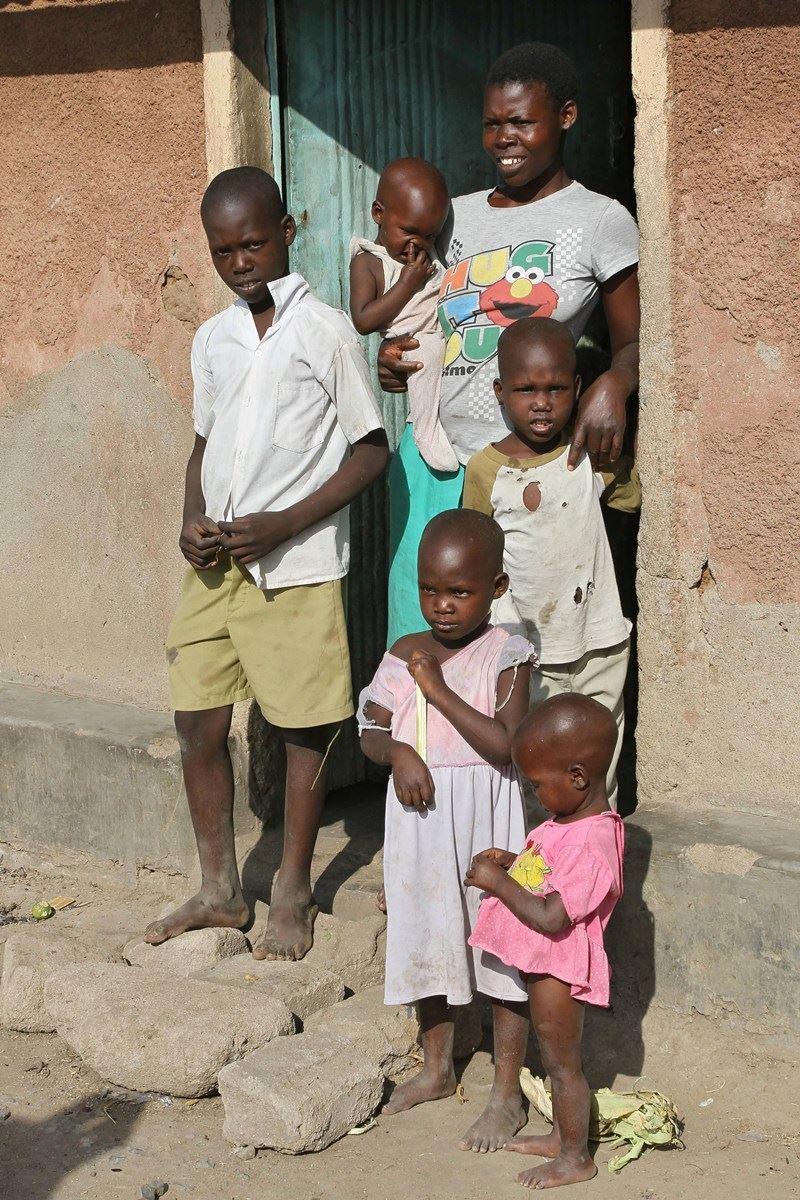
Kenyan Economy

Figure 1.--The photo was taken in Kisumu, western Kenya. It shows a mother with her five children. The family lives in a bricks house, so they are not in the lower economic class of Kenya society. The children wear old casual clothing. Probably the older boy is wearing his school uniform. This looks poor by European standards, but it shows the enormous economic progress made un Kenya. Kenya is on tract to become the first East African country to make the transition from low-income status to middle-income status.
|
|
Kenya was divided into tribl areas befire the arival of the British. Economic activity was mostly agriculture and livestock raising. The are was ravaged by the Arab slave trade which the Royal Navy worked for decades to end. European colonialism in East Afric came later than West Africa. There was interest in the port of Mombasa, but little penetration of the interior. The British established the East Africa Protectorate (1895) which after World War I became the Kenyan Colony (1920). The rich farm land an tmperate climate of the interior attracted British settlers who with the support of the colomial government acquired land from tribal areas. Native resistance inspired the Mau-Mau Rebellion (1950s). Britain granted independence (1963). The country's economy has done better than most of the newly independent African countries and is the East African success story. Kenya has reported generally positive with a few poor years since independence. Immediately after independence, Kenya reported impressive growth rates of about 6 percent (1960s) which gradully declined to viut 4 prcent (1970s-80s). Kenya then experienced wide fluctutions in growth rates (negative to 4 percent) (1990s). After the new century, we see some very high growth rates, peaking at 7 percent (2007). The global financial crisis combined with a diputed election, hit the economy. Exports and remitences were affected. Growth fell below 2 percent which was not as bad as many other countries experienced (2008). The economy quickly rebounded, resuming a healty growth rate. Kenya was soon reporting growth rates over 5 percent (2010-11) and most economists see generally positive prospects. The Islmicist violence in Somalia to the north has advrsely affected important industries like tourism. Kenya is on tract to become the first East African country to make the transition from low-income status to middle-income status. The per capita GDP is over $750. While low by European standards, it is an impresive achievement by African standards, especially as Kenya does not have any major exportable raw materils like oil. The country has been adversely affected by high inflation rates. The Government is promoting policies to increase exports and invest in infrastructure (transport and energy). There has been succes to increase regional trade through the East African Community (EAC) trade bloc. This includes Kenya, Uganda, Tanzania, Rwanda and Burundi. The EAC like Kenya is pursuing pro-market, pro-private sector and pro-liberalisation. While Kenya has pursued those policies since independence, other EAC counties have not. Several of it partners pursued socialist, planned economic policies and achieved far poorer results. Thus there is a significant integrtion process underway and as a customs union and the common market are being forged. Kenya is the EAC leader and the most most industrialised country, not only in East Africa, but Central Africa as well.
Agriculture has been and continues to be the keading economic activity. The agicultural sector, unlike quite a number of African countries, is not dominated by aingle or small number of commodities. This is in part because of Kenya's vrious regions have different climaric conditions. Keny's agricultural sector produces aide range of horticultural products. Tourism is another important sector. Important parks nd wildlife are the major attraction.
There is a gowing manufacturing industry. Kenyan exports are primarilt agricultural and raw mateials, but value added manufcturing is increasing. Kenya has had to import oil. Declining oil prices since 2014 have been a benefit and there are indications that oil fiekds could be develped in the north.
CIH

Navigate the Children in History Website:
[About Us]
[Introduction]
[Biographies]
[Chronology]
[Climatology]
[Clothing]
[Disease and Health]
[Economics]
[Freedom]
[Geography]
[History]
[Human Nature]
[Law]
[Nationalism]
[Presidents]
[Religion]
[Royalty]
[Science]
[Social Class]
[Bibliographies]
[Contributions]
[FAQs]
[Glossaries]
[Images]
[Links]
[Registration]
[Tools]
[Children in History Home]
Navigate the Boys' Historical Clothing national pages:
[Return to the Main Kenyan page]
[Return to the Main African page]
[Return to the Main African country economics page]
[Angola]
[Cape Verde Islands]
[Democratic Republic of the Congo]
[Ethiopia]
[Gabon]
[Lessotho]
[Madagascar]
[Mali]
[Somalia]
[South Africa]
[Uganda]
Created: 8:50 AM 2/23/2016
Last updated: 8:50 AM 2/23/2016



